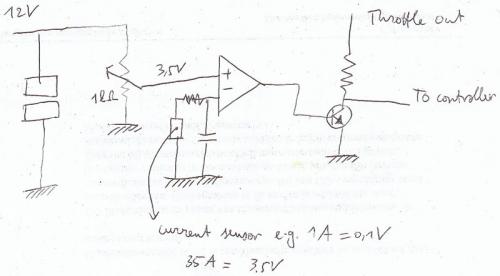Hi folks,
I've got an idea for a mod to my EVT 4000e.
I want to limit the current to a much lower value than it is limited to now. I did an inductive measurement and I came up with a worst case current of about 85 A. I consider that too much for 50Ah batteries if I want them to last. I'll make the 60V mod soon, so the worst case current will become even higher.
I see two ways a limiting could be implemented. I could change something to the control unit so its current limiting function kicks in much sooner. Or I could hook an inductive current measurement device up to a circuit that influences the function of the throttle pot.
What do you think?
Thanks,
Wim



You could grind some metal off the controller shunt in a trial and error fashion testing the max current each time you grind some off. That would be much easier.
[url=/forum-topic/motorcycles-and-large-scooters/587-my-kz750-electric-motorcycle-project]KZ750 Motorcycle Conversion[/url]
[url=/forum-topic/motorcycles-and-large-scooters/588-fixing-my-chinese-scooter]900 watt scooter[/url]
Pic from http://www.electri
Hi Andrew,
Good idea... but with a strong drawback: it's destructive!
:-(
Wim
If you want to make an omelet, you're going to have to break some eggs. ;-)
<table border="0" style="border:1px solid #999999; padding:10px;"><tr><td>
<a href="http://www.BaseStationZero.com">[img]http://visforvoltage.org/files/u419...
[size=1][color=black]www.[/color][color=#337799]BaseStationZero[/color][co
I was really looking for the non-egg-breaking omelet! ;-)
Anyway, just posting an idea here. Would this work?
I would probably use a commercially available current sensing device that gives a clean simple output voltage without overheating itself or breaking down or whatever. I'm sure that can be found.
The op amp would compare the current to the maximum allowed value, and when reached, bring the throttle signal down.
But it's a very long feedback loop, from throttle to motor to actual current back to throttle. Do you think it would nicely stabilise to the maximum current when reached? Or would it start to oscillate out of control? A full system analysis seems too difficult for me, but someone with a bit of hands-on experience can probably guesstimate this.
I thought I'd add a parallel capacitor to the current sensor to keep short spikes from influencing things too much. Any ideas on that?
Later,
Wim
Has EVT changed the controller design? On my 2002 model EVT 4000 the throttle is a mechanical cable that goes into the controller, and the throttle position sensor is not a potentiometer but a gizmo that uses light sensors to register the position of the end of the throttle cable.
I mean your general idea makes a lot of sense and the Cycle Analyst can be configured to do as you say. But the Cycle Analyst requires connecting to a specific kind of throttle, which is a different kind than EVT used in 2002.
- David Herron, The Long Tail Pipe, davidherron.com, 7gen.com, What is Reiki
Actually, I didn't look into the throttle design yet. I subconsciously assumed it worked like that...
That cycle analyst looks interesting, but if you're right, it won't work for me then.
If I can't influence the throttle, I need to limit the current in the main path, which is far more difficult and creates an extra efficiency loss.
:-(
I got the following message from ScooterTech (member of voltsrider.com forum)
Hope that helps.
[url=/forum-topic/motorcycles-and-large-scooters/587-my-kz750-electric-motorcycle-project]KZ750 Motorcycle Conversion[/url]
[url=/forum-topic/motorcycles-and-large-scooters/588-fixing-my-chinese-scooter]900 watt scooter[/url]
Pic from http://www.electri
Unfortunately David was right: the throttle works with a cable going into the controller. So it probably uses the light detection scheme David mentioned. Maybe that can also be influenced, I'll have to open up the controller to check. I expect this to be difficult, though.